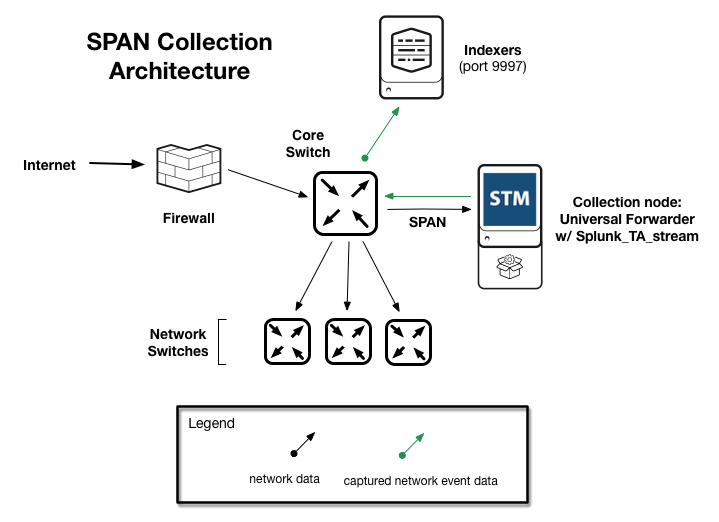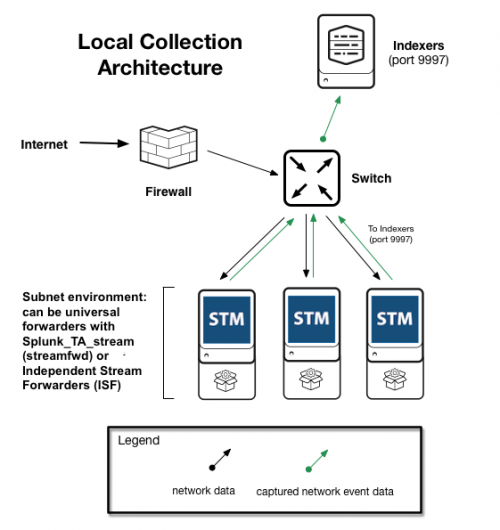Determine your network data collection architecture
Install the Splunk add-on for Stream Forwarder on your network where you want to capture network data. Before you deploy Splunk Stream determine the best location for your Stream forwarders:
- Review the network or network segments that contain the hosts you want to monitor.
- Review the network collection architectures in this topic to determine the best method to capture data.
Once you determine the data you want to collect, determine the network collection method.
- Local collection that collects data on each machine that you monitor
- Switched Port Analyzer (SPAN) collection
- Test Access Port (TAP) collection
Configure Local collection
Local collection is useful, for example, to help capture data from individual network nodes in a subnet environment such as a multi-tier web site.
To use local collection, install a universal forwarder and the Splunk Add-on for Stream Forwarder on each host on the network or network segment that you want to monitor.
You can configure local collection manually or use the Splunk deployment server.
Configure SPAN or TAP collection
Switched Port Analyzer (SPAN) and Test Access Port (TAP) collection require that you have an existing collection node that listens to all traffic on a network or network segment using a SPAN port or network TAP.
install Splunk Add-on for Stream Forwarder on a universal forwarder or deploy an Independent Stream Forwarder (ISF), then configure that forwarder as the listener on the SPAN or TAP interface.
This diagram illustrates a distributed Splunk Stream deployment with a SPAN collection architecture:

Considerations for local, SPAN, and TAP collection
This table highlights pros and cons of local, SPAN, and TAP collection architectures.
| Collection type | Pros | Cons |
|---|---|---|
| Local |
|
|
| SPAN |
|
|
| TAP |
|
|
Additional considerations for SPAN collection
SPAN collection requires a few additional considerations.
- Can the Network Interface Card (NIC) that receives the mirror data handle the influx of traffic? For example, a 1GB NIC can not handle the data volume from a 10GB port.
- Does the SPAN mirror port contain both ingress and egress traffic from all of the ports they are spanning? If yes, then the capacity of the NIC itself is even more important.
- Does the mirror device generate NATed data (in which case the data contains both internal and external (Internet) representations of traffic)?
- What is the volume of source traffic? Depending on the volume of traffic, you might need to make some performance adjustments to ensure that the system behaves as expected.
| Splunk Stream for Cloud deployment architecture | Install Splunk Stream on a Managed Cloud deployment |
This documentation applies to the following versions of Splunk Stream™: 8.0.1, 8.0.2, 8.1.0, 8.1.1, 8.1.3, 8.1.5

 Download manual
Download manual
Feedback submitted, thanks!